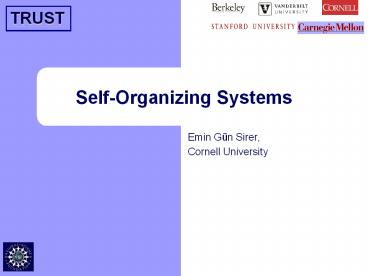Self-Organizing Systems - PowerPoint PPT Presentation
1 / 15
Title: Self-Organizing Systems
1
Self-Organizing Systems
- Emin Gün Sirer,
- Cornell University
2
Focus Area
- Self-organizing systems
- Future systems will be increasingly networked,
increasingly complex, and increasingly difficult
to manage manually - Beehive / CoDoNS
- A secure peer-to-peer overlay to supplant and
replace DNS - MagnetOS
- A distributed operating system for ad hoc
networks - Herbivore
- A peer-to-peer anonymous communication system
3
Beehive
- Domain
- Critical infrastructure, DNS
- Structured peer-to-peer overlays
- Problem
- DNS is open to denial-of-service attacks
- Structured P2P systems do not provide low-latency
lookups - Approach
4
Beehive Approach
- general replication framework
- suitable for structured DHTs
- decentralization, self-organization, resilience
- properties
- high performance O(1) average lookup time
- scalable minimize number of replicas and reduce
storage, bandwidth, and network load - adaptive promptly respond to changes in
popularity flash crowds
5
Beehive Intuition
- tunable latency
- adjust extent of replication for each object
- fundamental space-time tradeoff
0021
0112
0122
2012
6
Optimal Closed-form Solution
, 0 ? i ? K 1
xi
, K ? i ? K
1
where d b(1- ?) /?
K is determined by setting xK-1 ? 1 ?
dK-1 (K C) / (1 d dK-1) ? 1
7
Beehive Results
- Built and deployed a replacement for DNS based on
the Beehive result - 50-100 PlanetLab nodes additional ISPs, CNNIC
(.cn registrar) - high performance
- low lookup latency
- median latency of 7 ms for codons (planet-lab),
39 ms for legacy DNS - secure
- resilient against denial of service attacks
- load balances around hotspots
- self configures around host and network failures
- fast, coherent updates
- no TTLs, updates can be propagated at any time
8
MagnetOS
- Domain
- Ad hoc networks of mobile nodes
- Problem
- No programming model
- Hard to develop applications
- Need an arbiter
- Approach
- An adaptive single system image operating system
9
Approach
- Provide a unifying single-system image
abstraction - The entire network looks like a single machine
- MagnetOS performs automatic partitioning
- Converts applications into distributed components
that communicate over a network - MagnetOS provides transparent component migration
- Moves application components within the network
to improve performance metrics
10
Automatic Partitioning
- Provide a unifying single-system image
abstraction - The entire network looks like a single machine
- MagnetOS performs automatic partitioning
- Converts applications into distributed components
that communicate over a network - MagnetOS provides transparent component migration
- Moves application components within the network
to improve performance metrics
JVMApp
MagnetOS Rewriter
11
MagnetOS Results and Open Issues
- Power-efficient
- Extends system lifetime by a factor of four to
five over the standard approaches - Open issues
- Fault-tolerance for application components
- Power-efficient routing and placement techniques
- Software techniques for large-scale network
simulations
12
Herbivore
- Domain
- Wide area networks, e.g. Internet
- Problem
- Communication protocols do not provide privacy
- Approach
- A scalable, efficient, provably anonymous
communication system
13
Herbivore Approach
- Provably anonymous
- Dining cryptographer networks
- Scalable
- Divide and conquer the network into cliques
- Efficient
- Wire-level protocol sends only two bits per
client
14
Herbivore Results and Open Issues
- First practical anonymous communication system
- Anonymous unicast and broadcast primitives
layered on top of the insecure Internet - Prototype deployed to 50 sites across the
Internet - Achieves 200 Kbits/second, 500ms latency!
- Design of anonymous applications still an open
issue - Messaging, Filesharing, Web-browsing, Voting,
15
Further Information
- E. Gün Sirer
- egs_at_cs.cornell.edu
- http//www.cs.cornell.edu/People/egs/































